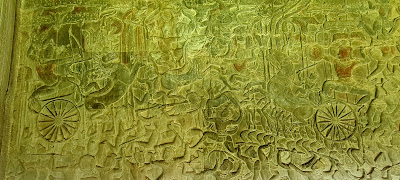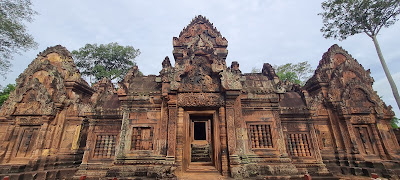The Thai flight from Suvarnabhumi to Phnom Penh lands five minutes ahead of ETA. I had opted for an eVisa for my visit, thus avoiding the long queue under `visa on arrival’. I timed myself from aircraft alighting, passing through immigration check, baggage collection and boarding a cab. Twenty one minutes. This is a good start!
******
Prima facie, there is little to suggest an
Indian influence in these parts. Scratch the surface, and nuggets appear. The
etymology of three places in Cambodia serve as examples.
Consider Angkor. It is a corruption of the
Khmer word `Nkor’ which, in turn, is derived from the Sanskrit `Nagar’, i.e.
City.
The Rolous Group of temples lies 13 kms off
Siem Reap, and was the capital of the Khmer kingdom around the 9th –
10th centuries. The locals refer to this place as Harihara-alaya.
Hari + Hara + Alaya; in other words, the abode of Vishnu and Shiva.
On the south-west fringes of Phnom Penh lies
Chaktomuk, a serene place to watch the sunset from a barge. It lies at the
confluence of four rivers; Tonle Sap (2 branches), Bassac and Mekong. Chaktomuk
is a corruption of the Sanskrit word `Chaturmukh’, i.e. four faces.
******
On the return bus ride from Siem Reap to Phnom
Penh, I sat next to a man about my age. We got talking. He was a pisciculture
expert, involved in several riverine fish breeding projects in the country. He
talked about Tonle Sap, the country’s main river. It is the only river in the
world that reverses direction in water flow every year, based on seasonality.
With the onset of monsoon in June, the river flows upstream, away from the sea,
and empties into Tonle Sap Lake (the largest freshwater lake in south-east
Asia) for the next four to five months.
 |
| Bend in Tonle Sap at Phnom Penh |
******
My early memories of Phnom Penh were of a
quaint, sleepy outpost emerging from the scars of Khmer Rouge. It was one of
those rare capital cities with no public transport infrastructure; it still does
not have one. Over the past decade, there has been an explosion in construction,
and vehicles on clogged roads. All in the name of development, or as our
Government is fond of reiterating……`Vikaas’.
Two, three and four wheelers jostle for limited
road space…..politely. The usual global big guns in the motor vehicles world fight
for market share for two and four wheelers. The tuktuk or three-wheeler
segment, however, is an absolute duopoly……between Bajaj and TVS. My heart
imperceptibly swells, ever so slightly.
******
More on the ongoing real estate boom at Phnom
Penh. Skyscrapers, blocked views, reflecting glass buildings, sharp angles,
blinding LED displays……the city skyline has acquired that numbing sameness
prevalent in most other metros.
Siem Reap offers a welcome change. There is
something about red-tiled slanted roofs, pagoda-esque, that’s easy on the
eyes!
 |
| Phnom Penh skyline |
 |
| Siem Reap skyline |
******
I meet John at Lost Bar & Grill, located on
the toney promenade of Sisowath Quay. Looks-wise, he appears as a slimmer version of
Telly Savalas, and prefers being dressed in all black. He hails from Boston
suburbs. He hasn’t been to the USA in thirty-five years after setting foot in
these parts. John cut his teeth in the construction equipment hiring business
in the Siem Reap area, graduated to a road building contractor before stepping
off the gas to open this bar at Phnom Penh a couple of months ago. Lost Bar
specializes in all forms of beer off the tap. Business is looking up. John is
happy to let me play my own music from YouTube in an establishment devoid of
other customers.
Across the counter a bespectacled, studious
young lady caters to my thirst. Her name is Alli, and she’s from Siem Reap. She
is 24. We start a conversation. Alli graduated in banking and finance from the
Royal University of Cambodia and took up this 3 PM to 11 PM job. The pay is
decent, and she gets to have spare hours in the mornings. She shares a small
apartment at Phnom Penh with her brother, who works at a real estate firm.
“With your academic background, you could have
landed a job at one of several local or international banks,” I say.
“I do not want one. I receive feedback from my
batchmates about the high levels of stress at banks. And such a job does not
align with my objective,” she responds.
“So what is your objective?”
“I utilize my free time in the mornings to
prepare for my masters at the university, which I will attend next year.”
“And what thereafter?”
“I will take up a teacher’s job at a high
school or college at Siem Reap, and be with my community.”
Perspective! Experienced `Swades’ first hand.
******
Surviving the hot, humid and sticky weather is
a challenge. Cambodia has a sensible solution to beat the tropical heat.
It is called beer.
Beer encompasses your daily life. A large
proportion of hoardings advertise all brands and forms. Beer is available off
the shelf at daily needs stores and mom-and-pop shops; at prices that compare
favourably with mineral water.
Some of the brands are well established. There
is the eponymous `Cambodia’. `Angkor’ is not far behind, with its word-played
`Anchor’ offering meaningful challenge.
The new kids on the block are more interesting.
`Ganzberg’ bears no relation with the Beat Generation icon. Its name is derived
from a combination of G for German (because it is advertised as beer made with premium German technology) and perhaps from the promoters’ fascination for
Carlsberg.
I see dark clouds of a diplomatic stand-off brewing
between Cambodia and India. The current rage in Cambodian beer-dom is a robust,
full-bodied stout (Alc. 5.3% Vol). It is only a matter of time before the
bhakts get wind of this offering. It is called Hanuman.
******
I can confirm, with much happiness, that the industry
in fakes and replicas thrives like never before. This straddles the world of iconic
brands in fashion and allied accessories. For the discerning visitor, it is vital
to distinguish between a fake and a replica. A fake usually involves a shoddy
rip-off, often with a re-arrangement of letters in the name. The end-product
often also lacks finesse. A replica, ah monsieur, has the touch of an artiste! Pictures
speak louder than words. Check out the catalogue samples below.
 |
| Replica |
 |
| Fake |
 |
| Fake |
 |
| Fake |
 |
| Replica |
 |
| Replica |
******
Officially, it is called the Kingdom of
Cambodia. The day after I reached Siem Reap, the country celebrated the Queen
Mother’s birthday with much joy. But as Lennon / McCartney wrote, “Her Majesty
is a pretty nice girl, but she doesn’t have much to say.” Cambodia matches UK
as a constitutional monarchy. Although it is described as a multi-party
democracy, ruling power has rested since 1985 with Hun Sen (a Khmer Rouge
defector) and his Cambodian Peoples Party. Hun Sen’s outlook may be paraphrased
in that quote of Henry Ford about Model T…..`people can vote for anyone, as
long as it is the Cambodian Peoples Party’.
******
People in the Khmer kingdom originally adopted
Hinduism. Towards the end of the 12th century, the majority converted to Buddhism, led by the royal family. The intricate reliefs sculpted in the western gallery of
Angkor Wat depict scenes from the Indian epics. Ramayana permeates sections of
Cambodian society even today. Inexplicably, the Mahabharata is virtually
unknown in modern Cambodia. The walls of the southern section of the western
gallery are dedicated to the battle of Kurukshetra. A large contingent of
middle-aged Americans arrive to view this section. Here is a rough
transcript of what their tour guide had to relate about this section, which I
overheard.
“What you see are scenes from the final Battle
of Kurukshetra, as described in Mahabharata. ‘Maha’ means `great’ and `Bharat’
means `war’. This was a war between two brothers; one good and the other evil.
The good brother ultimately beat the evil one, primarily because he had the
blessings and guidance of Krishna. Krishna is another name for Lord Vishnu, to
whom Angkor Wat is dedicated.”
Go figure!
 |
| Bhishma on his bed of arrows |
 |
| Karan - Arjun letting it rip |
******
All visitors to these parts have their favourite
Angkor temples. Mine lies beyond the Angkor Archaeological Park, 25 kms
north-east of Siem Reap. Banteay Srei is a 10th century Shiva
temple, pre-dating Angkor Wat by a couple of centuries. It is a miniature
marvel of intricate carvings in red sandstone. In Khmer, `Banteay Srei’ means
`the city of women’. But this is a contemporary name derived from a phonetic
pronunciation of `Banteay Sri’, the `auspicious city’. Inscriptions excavated
at the site gives its original Sanskrit name as `Ishwarapura’, the `city of
God’. The four `dwarpalas’ (guardians) in the inner sanctum are intriguing.
Their faces are a mixture of Garuda (the bird) and a monkey.
******
Do not miss out on a show of Phare Circus when
at Siem Reap. This is a remarkable project that originated at Battambang in
1994 with nine children from refugee camps in the aftermath of Khmer Rouge. A
monk took them under his wings and taught them painting and art as therapy to
overcome their trauma. This initiative metamorphosed to an art and public
school, where free education is provided. A music and theatre school came up
next. Finally, for kids who wanted more, the circus school emerged. Phare has
produced 250+ shows around the world, including in far flung countries like
France and Russia. In 2021, it entered the Guinness Book of World Records as
the longest running single circus show, timed at 24 hours 10 minutes! But this
is a list of achievements only. The Phare Circus show is a dizzying, jaw-dropping,
synchronous amalgam of art, folklore, theatre, music and acrobatics. One for
the ages.
******
Finally, I dedicate a section to Chea Nor, my
friend, philosopher and tuktuk man at Angkor. Physically, Chea is a combination
of four outsized football; a couple that pass off as legs, a small one that
represents his head and the largest one that comprise the rest of his body. Chea
is the ultimate gadget freak and multi-tasker. He contends that his tuktuk is
air-conditioned. What that means is that there is a blower in the shape of an
AC vent that is directed at the passenger section. He has installed a mini
refrigerator in the boot. After each halt in oppressive weather, he offers a
bottle of chilled water and cold towels …. with a smile. Three smartphones are
installed on mobile stands in front of his steering wheel. One is dedicated to
WhatsApp and a second one to Telegram. He maintains a constant two-way
communication via recorded messages on these two apps, ostensibly with his
fellow tuktuk brethren and commission agents. On the third phone, he is on facetime,
in animated dialogue with a woman who I assume is his wife. All these
activities occur simultaneously, as he keeps watch on the road whilst driving.
At each halt, he unpacks a portable hammock from the boot, hangs it from the
branches of two trees, goes horizontal and renews his arguments with his wife.
Life’s good!
 |
| Note the smartphones! |
 |
| Tuktuk with an AC! |
******














No comments:
Post a Comment